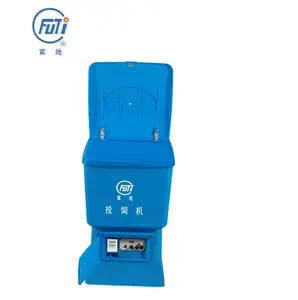
All categories
Featured selections
Trade Assurance
Buyer Central
Help Center
Get the app
Become a supplier

(1380 products available)














































Auto fish feeders are devices designed to automatically dispense fish food into aquariums or ponds. They help maintain a regular feeding schedule for fish, which is particularly useful for fish owners who are often away or have a busy schedule. Here are some key aspects and benefits of auto fish feeders:
Drum type auto fish feeder:
This type of feeder uses a rotating drum mechanism to release food. As the drum rotates, food particles are exposed and fall into the water. It usually has adjustable feeding times and portions. The rotation speed or angle of the drum determines how much food is dispensed each time. It is ideal for larger fish farms with many fish. It can feed pellets, flakes, and granules.
Chain plate type auto fish feeder:
This feeder uses a chain mechanism to move food towards the dispensing area. It consists of several plates linked together to form a continuous chain loop. The size of the chain plates determines the amount of food they hold. It works well for large ponds or tanks where consistent feeding is required. It can dispense various food types and is low in maintenance.
Screw type fish feeder:
This feeder uses a screw auger mechanism to move food along a screw coil. It is suitable for different types of fish food, including pellets and flakes. Screw feeders are durable and easy to clean. They usually have adjustable feed rates, and the diameter of the screw can determine how fast food moves. It is great for both aquariums and larger water bodies. It is low in power consumption.
Air pressure type auto fish feeder:
This feeder uses compressed air to operate. The compressed air pushes food out of the hopper through a nozzle into the water. It is precise and can be adjusted to release small or large amounts of food. It is suitable for delicate species that require specific feeding. It can work in extreme conditions and uses less electricity than other feeders.
Auto fish feeders have simple yet effective designs. They make sure that fish get their food on time, even when there is no one around to feed them. The key parts of these feeders are the food container, the feeding mechanism, the timer and control system, and the power supply.
Food container
The food container holds the fish food until it is time to feed the fish. It is usually made of clear plastic or glass so that the level of food can be seen easily. The container is designed to keep the food dry and prevent clumping. It may have a volume adjustment feature to control how much food is dispensed at each feeding.
Feeding mechanism
The feeding mechanism releases the fish food from the container. It can be a rotating paddle or a sliding door. The paddle or door moves to let food out into the bowl. The bowl is then dropped into the water for the fish to eat. Some feeders use a screw mechanism, which consists of a rotating screw inside the container. As the screw turns, it moves food to an open end, where it falls into the bowl.
Timer and control system
The timer and control system lets users set feeding times and amounts. Most auto fish feeders have a digital timer that can be set to feed fish once or twice a day. Some advanced models allow users to program multiple feedings per day and to adjust the amount of food dispensed at each feeding. The controls can be buttons on the feeder or a remote control or smartphone app in high-tech models.
Power supply
Power supplies for automatic fish feeders can be batteries or electricity. Battery-powered feeders are portable and easy to use but need to replace batteries regularly. Electric models provide constant power but require a nearby outlet. Some feeders are solar-powered, using solar panels to charge batteries for power supply.
The automatic fish feeders have many uses in different scenarios. They save time and ensure that fish are fed regularly in different situations.
Feeding tropical fish in an aquarium
People who keep tropical fish in aquariums as pets need to feed them regularly. With an automatic feeder, they can go on vacation and know that their fish will be fed on time. The feeder drops food into the water at set times, so fish get their meals even when the owner is not there to give it to them.
Feeding fish in a pond
People with ponds also need to feed the fish that live there, such as koi or goldfish. An automatic fish feeder lets the fish eat without the owner having to do anything. This is useful if the owner goes away for a while or if the weather is bad and the fish can't be fed manually. The feeder throws out food at regular times so the fish can keep eating even when no one is around to feed them.
Feeding fish for research
In some cases, scientists keep fish in water tanks to learn about them. To make sure the fish in these studies are fed properly without the researchers having to do it each time, an automatic feeder can be used. This is especially helpful when the scientists need to observe how fish act over long periods but do not want feeding times to affect what the fish do.
Feeding fish in public aquariums
Public aquariums are places where many people can come see different kinds of aquatic animals, including various types of fish. Feeding all the fish across such a large facility takes a lot of time for the staff members. To assist with this task, some fish tanks inside public aquariums use automatic feeders. These devices ensure that the fish get their meals on schedule while freeing up workers' minutes to attend to other aspects of animal care within the establishment.
Feeding fish in remote areas
Some individuals may raise fish in isolated locations far away from cities or towns. Even though they want their fish to grow healthy, it may be tough for them to give consistent manual feedings because of how far away everything is. An automatic fish feeder solves this problem by automatically dispensing meals even in hard-to-reach places. Whether someone is farming fish or keeping them as pets off the beaten path, a fish feeder ensures the fish eat as planned every day.
Wholesale buyers should consider these factors when choosing an automatic fish feeder to ensure it meets the needs of their customers.
Fish species and their feeding behavior
Different fish species have other feeding behaviors. Some fish eat at the water's surface, while others eat mid-water or at the bottom. Surface feeders, like goldfish, need floating pellets. Mid-water and bottom feeders need sinking pellets or a range of pellets that float and sink. Consider the size and age of the fish too. Young fish often need smaller pellets that are softer and easier to eat. Larger fish can handle bigger pellets. The feeder should be able to dispense the appropriate pellet size for the fish in the pond.
Pond size and fish stocking density
The size of the pond affects how much feed is needed and how widely it should be spread. A large pond with many fish requires more feed and wider distribution. But a small pond with few fish needs less feed, and concentrated distribution reduces competition stress. Choose a feeder with an adjustable output that can be set to dispense more feed for a large fish population and less for a small one to avoid over or underfeeding.
Feeder capacity and hopper size
The feeder's capacity and the size of its storage hopper matter for convenience and how long it will run unattended. A large hopper size means less frequent filling which is good for ponds that don't get visited often or have many fish that eat a lot. But a smaller hopper may be better if the feed is changed often or the pellet size needs to be varied for fish growth stages. It also helps prevent feed from going stale.
Power source and battery life
Consider the feeder's power source and battery life, especially for battery-operated models. Some feeders use AC power, while others use batteries or solar panels. Solar power works well for feeders that need sunlight and are in remote areas without electricity. It is also eco-friendly. But, feeders that need batteries should have long-lasting batteries, so they don't die during use. Rechargeable batteries are a plus. Consider the solar or battery options for feeders used in remote areas without electricity.
Durability and weather resistance
Automatic fish feeders should withstand harsh pond conditions and last a long time, so choose feeders made with durable materials like stainless steel or UV-protected plastic. These materials resist corrosion and damage from sun, rain, and snow. Weather resistance means the feeder will work in all seasons and in different climates, so it's reliable no matter the weather. This also reduces the need for repairs or replacements, making it more cost-effective for pond owners.
Q1: How can people adjust the feeding amount?
A1: Different feeders have different ways of adjusting the feeding amount. Some feeders allow users to adjust the amount of food dispensed at each feeding time. The total daily rations can be divided into several feedings, and the settings can be adjusted accordingly.
Q2: Are automatic fish feeders easy to use?
A2: Automatic fish feeders are designed to be user-friendly. They usually come with clear instructions for setup and operation. Many models also have intuitive controls and easy-to-read displays, making it simple to program feeding schedules and adjust settings.
Q3: How often should fish be fed with an automatic fish feeder?
A3: Most aquarium fish should be fed once or twice a day. Some tropical fish prefer small amounts of food several times a day. It's essential to research the dietary needs of the specific fish species to determine the appropriate feeding frequency.
Q4: What types of fish food can be used in automatic feeders?
A4: Automatic fish feeders can dispense various types of fish food, including flakes, pellets, granules, and crumble food. However, users should ensure that the food is suitable for their fish and that it fits the feeder's specifications.
Q5: Do automatic fish feeders work with any size of aquarium?
A5: Automatic fish feeders are compatible with all sizes of aquariums. However, the size of the aquarium may influence the type of feeder required. For larger aquariums, a bigger capacity feeder or multiple feeders may be needed to ensure all fish receive adequate food.